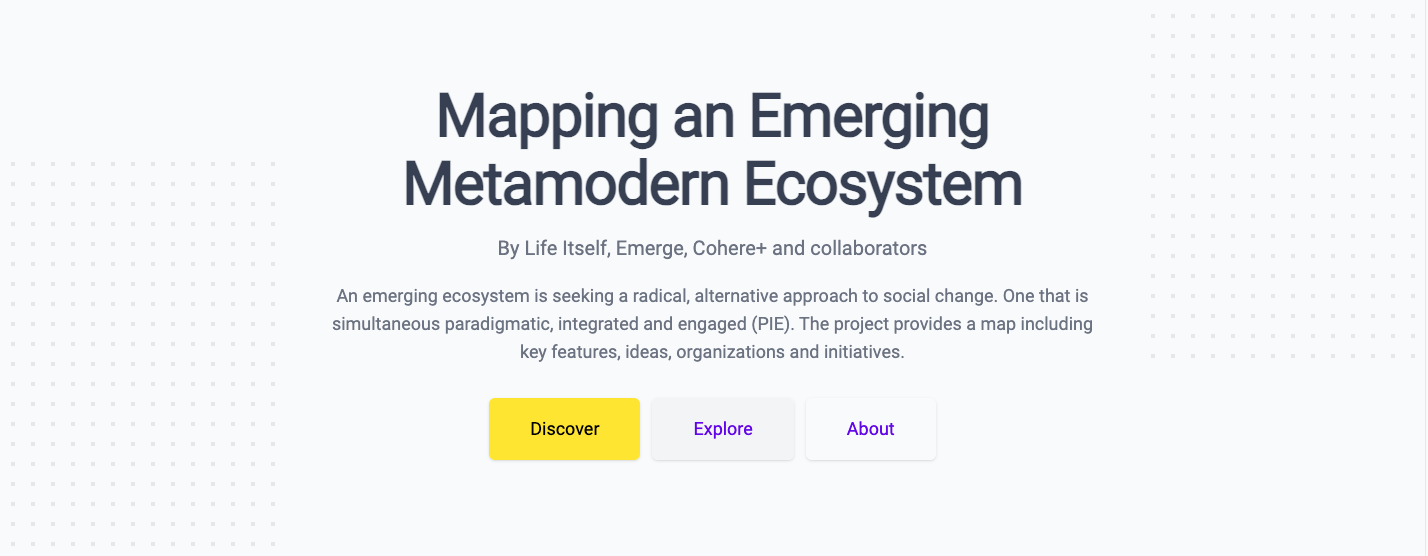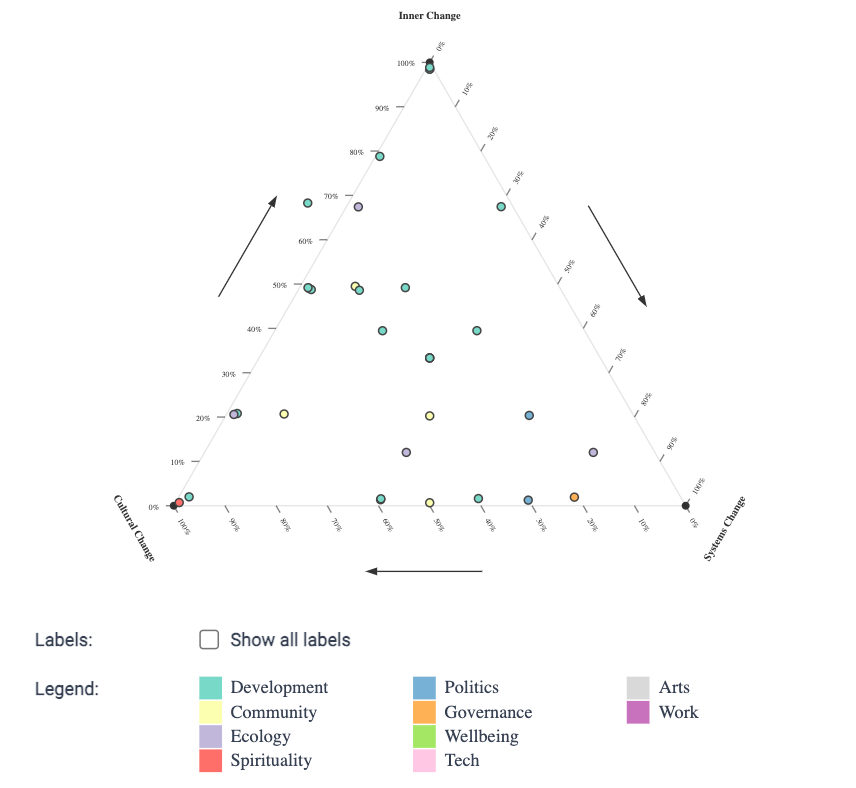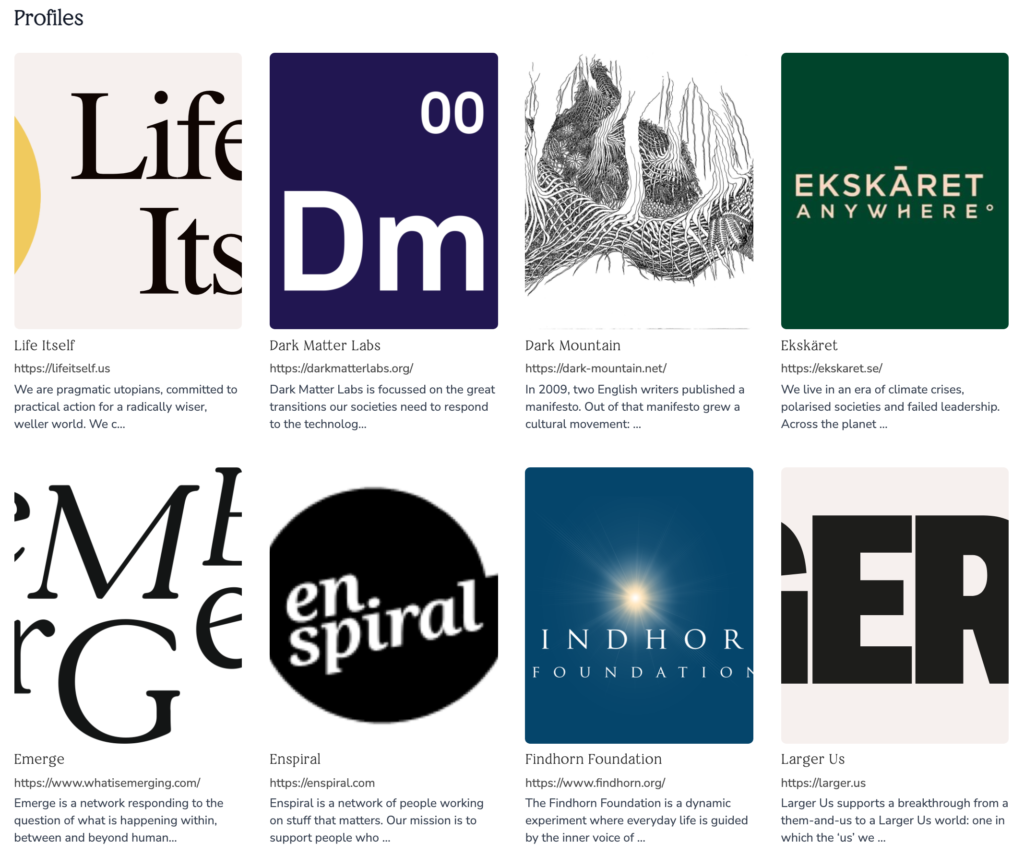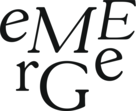PIP for Social Change: Mapping an Emerging Ecosystem of Paradigmatic, Integrative, and Pragmatic Change Agents
This page documents the second phase (2021-2022) of Life Itself's ecosystem mapping work, including:
- Background: A newly emerging ecosystem & What we know about it so far
- Current focus: Mapping the ecosystem so that it becomes (more) self-aware, interconnected, resourced and effective
- Overview of the "PIP" ecosystem for Paradigmatic, Integrative, and Pragmatic Change
- Visual Mapping of "PIP" organisations
- Directory of "PIP" organisations
- Collaborations: Preliminary research interviews & Partnerships
This work builds on the first phase (2019-2020) of ecosystem mapping work, which you can read about here.

What follows below is a comprehensive written "report" on the 2021-2022 mapping work, including background and context. If you would like simply to discover and explore the ecosystem in a more interactive way, e.g. to get an overview of its key characteristics, and explore a directory and visualisations of organisations within it, please visit this site.
1. Background: A newly emerging ecosystem
A newly emerging ecosystem of individuals, organizations and initiatives around the world has begun to form in recent years. We know that many of them are trying to create change, often by shifting how we make sense of the world and how we engage with one another — in short, by engaging in sense-making and culture-making. Some of the multiple terms and names that we're aware of for it are: Metamodern, Polycrisis, Metacrisis, Great Transition, Liminal Web, Sensemaking Web, Intellectual Deep Web, and Emergentsia.
But there is still a lot more to learn about this newly emergent space. For example: What are its defining characteristics? How do organizations differ, and how are they similar? What is this space? What are the other ecosystems to which it is interconnected? And how will it evolve?
Better understanding of the ecosystem could help it to become more known, interconnected, resourced, and effective.
Previous work: What we know about the ecosystem so far
We have noticed and begun mapping an emerging ecosystem. Its nature, boundaries and name are not yet fully defined. In the previous, first phase of our work, we identified some of its key features:
There is a focus on systems, emergence, coherence, sovereignty, sensemaking as buzzwords, along with activism, governance, and regenerative culture. This is characterised by a strong lean towards spirituality (mindfulness) and the relationship between inner and outer life. At a higher level, we have identified three core thematic areas which tie together the varied groups in the space: collectivism, (w)holism, and counterculturalism and culture-making.
Beyond this thematic overlap we have identified four major areas of activity: physical spaces, research, media/publishing and events. Nonetheless, it has been notable that many organisations have shifted to multi-channel working across a number of these (e.g. producing media content as well as running retreats and events).
For more detail, and to see a bigger list of key terms, you can read and download the full 2020 report here.
2. Current focus: Mapping the ecosystem so that it becomes (more) self-aware, interconnected, resourced and effective
This project seeks to map the emerging ecosystem around social change for a new paradigm. We're seeking to provide an overview of the organizations in the space and better understand what they focus on, by what means, and what ties them together. We hope from this we can start to give a more coherent shape, name and set of key terms to the space.
We are undertaking research to gather information on organizations, communities and individuals that are potentially part of this ecosystem – as well as the connection to nearby spaces.
The first stage of the project involves the creation of a directory, outlining the types and areas of focus of these organizations. Over time, we plan to conduct more in-depth analysis to map the ecosystem and chart how actors relate to each other across a number of dimensions.
Why Map?
Currently, the ecosystem is largely uncharted and undefined – making it hard to discover, navigate, and engage with. Furthermore, within the ecosystem, efforts are often duplicated or not as strategically aligned as they could be. We hope that mapping the ecosystem helps it to become (more) visible, self-aware, interconnected, resourced and effective.
Charting this new territory is valuable for two main reasons. First, and most importantly, mapping makes it identifiable and visible. This supports engagement with the broader “mainstream” which is vital as we move from philosophizing about social transformation towards taking the kinds of action that make it a reality. Second, it helps the ecosystem’s coherence, cohesiveness and self-awareness. This supports connection both within and without the space leading to greater and better collaboration. It supports a better division of labor meaning greater efficiency and effectiveness . And, finally, it supports members to situate themselves and their work in a broader context.
For more detailed analysis of our motivations for mapping, read our essay 'Mapping for Emergence' (2021): https://lifeitself.org/blog/2021/12/09/mapping-for-emergence.
3. Overview of the "PIP" ecosystem for Paradigmatic, Integrative, and Pragmatic Change
We sense that a new ecosystem, or ecosystem of ecosystems, is emerging. A growing number of people, organizations and initiatives are taking alternative approaches to social change, which diverge from both mainstream and progressive action within civil society and the social economy.
The ecosystem we explore is still emerging and ill-defined. There is no one name for this ecosystem, with different organizations favouring different terms. As mapped, it is quite broad – even disparate. Nevertheless, there are commonalities.
Most importantly, this ecosystem has a novel approach to social change. Specifically, an approach that is simultaneously paradigmatic, integrated, and pragmatic.
Secondly, there are a variety of commonalities in outlook and approach. The most noteworthy identified so far we have termed: post-individualism, (w)holism and culture-making (in the form of new norms and narratives).
There is also a focus on complexity, systems and emergence, on developmental models, spirituality and practice, and on sensemaking, different forms of knowledge and global-local activism. Other commonalities include an interest in decentralized governance, new narratives, alternative social imaginaries and regenerative culture.
Nonetheless, the boundaries, relationships and patterns of influences in the ecosystem remain blurry, with our present awareness feeling like it only touches the tip of the iceberg. Questions that remain unclear include who exactly comprises the ecosystem, how activities and visions relate to one another, where the coherences and tensions lie and how it might evolve.
"PIP": A Novel Approach to Social Change
The defining feature of this ecosystem is its novel approach to social change. Specifically, the combination of being paradigmatic, integrated, and pragmatic. We emphasize that it is the combination of all three that is important and distinctive.
Paradigmatic
There is the belief that the change required is paradigmatic. That is to say, it seeks a transition of the entire social paradigm at both a systems and "ontological" (worldview and narratives) level. This contrasts with approaches that either simply seek reform e.g. making market liberalism better, or transformation that is deep but only in a given area e.g. transforming our structures of economic production and ownership but leaving base assumptions about who we are and how we relate to the natural world untouched.
Integrative
It identifies the need to incorporate methods and routes to change spanning a variety of fields and "locations" (e.g. personal, cultural, institutional etc). One central and basic example common to most (though not all) actors is the belief that inner and outer transformation have to go hand in hand. In Integral terms it is "all-quadrant" and in particular, prioritises the neglected "inner" quadrants.
Pragmatic
Participants are actively engaging with wider society for the purposes of social transformation. This sets it apart from groups which may be doing large amount of inner work but without connecting this directly and explicitly to broader social change, for example certain parts of the spiritual, developmental and psychedelic communities.
Core Characteristics: Post-individualism, (W)holism, Culture-making
Beyond the three pillars listed above, we also identify three high-level commonalities in outlook and approach: post-individualism, (w)holism and counterculturalism.
Post-individualism
Post-individualism takes two forms. First, a focus on groups rather than just individuals as a primary unit of analysis, and the idea that we must shift our engagement outwards from ourselves and towards a more widely beneficial orientation. Note that, unlike traditional "collectivism" (a term we previously used but abandoned due to its connotations), this does not entail abandonment of individualism, but the inclusion of its positive aspects back into group-centric concepts. The second form of post-individualism shows up as a broad commitment across the ecosystem to actually operating in networked and communal ways.
Wholism
What we have termed (w)holism (we use the 'w' to signify consideration of wholes, as well as operating holistically) refers to the views taken of social phenomena, social change and simply the world at large. There is a widely shared understanding of the world as a gestalt object, be this under the banner of interbeing used by Buddhist and more spiritual actors, the complex systems terminology used by groups such as the International Bateson Institute or the 'holon' and integral' labels taken up by Ken Wilber and the integral movement.
As can be seen by the paradigmatic focus and integrated approaches which we have identified as delineating the ecosystem itself, this (w)holism gives rise to a problem diagnosis which targets a deeper whole giving rise to negative social outcomes. These fundamental ways of approaching social change stem from a (w)holistic perspective more broadly, a fact which is further seen in the use of terms such as the metacrisis or polycrisis.
Culture-making
Counterculturalism for us is a desire to go beyond the dominant norms and narratives. This includes the norms of the progressive movement more broadly – perhaps its most surprising and interesting aspect. We also emphasize the culture in counterculturalism: for us, it is concerned with shifting the very foundations, worldviews and assumptions of our current order. In this sense it is a form of "culture-making".
To use the Wilberian terminology, there is a desire to move beyond the 'green' developmental stage which is currently taken to characterise Western liberal societies, and much of the progressive movement as a whole. This leads actors in the ecosystem to be more open to questioning or dispute social and political positions that may be understood as norms not just in wider society, but also those (for example understandings of inclusivity) within progressive circles themselves.
Language and Buzzwords
The language of the ecosystem draws heavily on concepts such as complexity, systems and emergence, developmental models, spirituality and practice, and on sensemaking, different forms of knowledge and ‘cosmo-local’ activism. Other commonalities include an interest in decentralised governance, new narratives, alternative social imaginaries and regenerative culture.
Activities
Emerging organizations and individuals are opting towards 'teal' style collaboration and community building in order to maximize resources as a generalist, lateral way of operating comes into view as a more effective way of tackling systemic problems.
We have identified four major areas of activity: physical spaces, research, media/publishing and events. Nonetheless, it has been notable that many organizations have shifted to multi-channel working across a number of these e.g. producing media content as well as running retreats and events.
4. Visual mapping of "PIP" organisations
To help us to see how different organisations within the "PIP" ecosystem fit together, we created two visual maps:
- Mapping organisations based on their approach to social change: This shows to what extent different organisations integrate the following three dimensions of change: inner change, cultural change, and systems change.
- Mapping organisations based on the main topic of their work: This shows the distribution of organisations across topics, and the predominance of topics, such as Ecology & Environment, Politics & Economics, Spirituality & Religion etc. within the broader ecosystem.
You can see and interact with the visualisations here.
Visual map of approaches to social change in the "PIP" ecosystem
For an interactive version of this visualisation, visit this page.

This visualisation maps organisations in the directory based on their approach to social change. The three broad orientations we have mapped are inner, cultural, and systems:
- Systems approaches focus on changing institutions and systems. Organisations focused on this area are particularly interested in areas such as governance, economics and technology.
- Cultural approaches focus on changing the broader collective culture, targeting aspects such as norms, values and collective narratives.
- Inner approaches focus on the inner transformation of individuals as a way of transforming society at large, both through personal development and shifting perspectives of how they relate to themselves, others, and the planet.
Each organisation was given a weighting across these three dimensions with the restriction that the overall total summed to one, reflecting the fact this was about the focus of their approach. Thus, being perfectly in the centre of this diagram would indicate that an organisation weighted each approach equally. Conversely, being at either corner would indicate the organisation totally prioritised that approach.
We emphasise that these scores were assigned according to the project team's best effort assessment based on available material. If you think an organisation has been mis-weighted please get in touch to let us know.
Visual map of topics in the "PIP" ecosystem
For an interactive version of this visualisation, visit this page.

This visualisation maps an overview of organisations in the directory grouped together by their primary topic. We have defined ten primary topics, each of which is represented by a circle within the broader circle/topic of social change. A short description of each topic follows below:
- Arts & Culture – Role and use of arts and culture in fostering social change.
- Community – Role of community in human life and in fostering human flourishing, and approaches to building, sustaining and governing communities.
- Development & Growth – Fostering personal development and growth in emotional, psychological, social and other inner capacities.
- Ecology & Environment – Issues relating to the environment, including climate change but also nature more broadly and human relationships to it.
- Future of Work – Innovating the world of work, including through new methods and approaches to business and organizational management.
- Governance & Institutions – Devising new forms of governance and institutions to support alternative social paradigms.
- Politics & Economics – Engaging with existing political and economic systems, creating policies and innovating new approaches to politics and economics.
- Spirituality & Religion – World beyond the material and the rational.
- Technology & Blockchain – Use of technological innovation, including blockchain, to foster social change and support new social systems.
- Wellbeing & Health – Improving quality of life through the physical, psychological, environmental and social determinants of health and wellbeing.
5. Directory of "PIP" organisations
One output of this mapping work is a searchable directory of organisations, communities and initiatives which can be filtered by topic and activity. The directory contains profiles of over 90 organisations.
You can explore the directory here.

6. Collaborations: Interviews & Partnerships
Preliminary Research Interviews
As part of our preliminary research, we undertook some conversational interviews in order to get a better sense of what is going on within the space and how people are seeing it. You can read the interviews here:
- Alnoor Ladha (Culture Hack Labs)
- Richard Bartlett (Enspiral, Loomio, The Hum, Microsolidarity)
- Joe Lightfoot (BioArc)
- Adam Brock (Regenerate Change)
- Romy Kraemer (Guerrilla Foundation)
- Robert Cobbold (Conscious Evolution)
Partnerships
We joined forces with the following partner organisations:
Emerge

Emerge is an independent, non-profit media platform and network responding to the question of what is happening within, between and beyond human beings in a civilisation that appears to be dying. Emerge connects transformative and inspirational innovators and initiatives across the globe. They spotlight the most daring pathfinders and visionaries who are using systems thinking, driving spiritual renewal or personal and cultural transformation, and who lovingly seduce cynical minds into seeing more beautiful alternative worlds.
Life Itself (Rufus Pollock and Theo Cox) and Emerge (Anna Schaffner) co-authored the essay 'Mapping for Emergence' (2021).
Institute for Integral Studies (IFIS)

IFIS is an independent research institute founded in 2008 and based in Freiburg, Germany, which has well established links with universities and other research organisations across Germany and Europe, as well as further afield. The Institute's mission is "to put an integrally informed science in service of society, the planet and a healthy development of both".
Disclaimer
We emphasize our work here is clearly preliminary and is limited by both our resources and knowledge. Based on snowball sampling starting from our contacts it necessarily and obviously displays clear biases e.g. geographically to Europe versus the rest of the world, and thematically in terms of areas chosen etc. We welcome feedback to help improve it.
Specifically, we are doing our best to give as accurate a representation of each organization we have listed. However, like everyone we make mistakes. If you believe the listing for your organization should be changed then please contact us and we'll correct it as soon as possible.